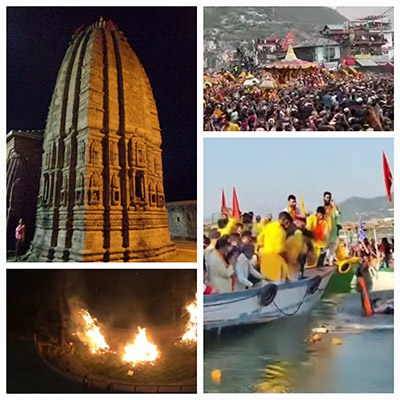Kullu/Shimla: Amidst the melodious chants of "Har Har Mahadev," the rhythmic beats of dhols, and the melodic tunes of cymbals, an enchanting spectacle unfolded as around 300 deities from across the district congregated in the temple town.
This vibrant gathering marked the start of the week-long International Kullu Dussehra, a sacred festival that banished the haunting memories of the recent deluge in the region.
Unlike the traditional effigy-burning ceremonies held across India, the people of Kullu follow a unique tradition. Instead of torching effigies symbolizing evil, they come together to pull the Rath (chariot) of Lord Raghunath, the revered deity of the land, to his campsite on Dhalpur Maidan, where He camps there along with other devtas including Hidimba Devi, who comes from Manali as a guest for the rest of six days.
Lanka Dahan takes place at the end of the Dusshera and devotees of the erstwhile family of Rupi King carry out the Ashtang Bali, sacrifice and share the feast among themselves.
This procession serves as the focal point of the Kullu Dussehra festivities, attracting thousands of devotees, devlus (local deities), and members of the dev Samaj (religious community).
In the capital city of Shimla, a different celebration took place. Residents gathered at Jhakhu temple hill top to ignite effigies representing the evil trio of Ravana, Meghnath, and Kumbhkaran, exploded them into the sky, accompanied by smoky trails.
Chief Minister Sukhvinder Singh Sukhu, PWD Minister Vikramaditya Singh, Shimla MLA Harish Janartha, and other enthusiastic participants joined in the festivities.
Meanwhile, in the town of Bilaspur, the BJP Chief, Jagat Prakash Nadda, rode a boat and united with the Dussehra crowd.
Together, they immersed effigies into the Gobind Sagar Dam, symbolizing the triumph of good over evil.
In Baijnath, however, Dussehra was not celebrated as a matter of deep-rooted tradition. The Baijnath temple, believed to have been founded by Lord Shiva himself, carries a unique legend.
It's said that in the Treta Yuga, Ravana, a devoted worshipper of Lord Shiva, carried a Shiva Lingam from Rakastaal near Mount Kailash to Lanka. Lord Shiva Gave him Boon to do so, but with a rider.
Lord Shiva, taking the form of the Lingam, instructed Ravana to keep it on the ground only when they reached Lanka. However, as they passed through Baijnath, in Kangra, Ravana halted to answer nature's call and entrusted the Lingam to a local shepherd named Baiju.
Baiju placed the Lingam on the ground and it is believed it remains there to this day as Lord Shiva's Boon went misfired.
Dussehra isn't observed in Baijnath as a sign of respect to Lord Shiva, as celebrating it would incur His wrath as it happened with Ravana. There are no Gold smiths in Baijnath as Lord Shiva consign Gold as any stone.
The temple of Baijnath was built in 12 the century by the then kumaon king dedicated to Lord Vaidyanath.
In Kullu, the International Kullu Dussehra officially commenced with the inauguration by Governor Shiv Pratap Shukla at Rath Maidan.
He also actively participated in the Rath Yatra of Lord Raghunath Ji, an event that draws both locals and tourists alike. Lady Governor Janaki Shukla was also present on this auspicious occasion.
The Governor's visit extended to the exhibition stalls set up by various government departments, boards, corporations, and non-government organizations.
He took the time to explore these exhibits and expressed his appreciation for their efforts. Furthermore, he inaugurated the International Folk Festival of Kullu Dussehra at Lal Chand Prarthi Kala Kendra, adding to the cultural richness of the celebration.
Among the distinguished guests in attendance in Kullu were Supreme Court Judge Sanjay Karol, Chief Parliamentary Secretary Sunder Singh Thakur, MP Pratibha Singh and others other dignitaries also participated in Dusshera festivities.







